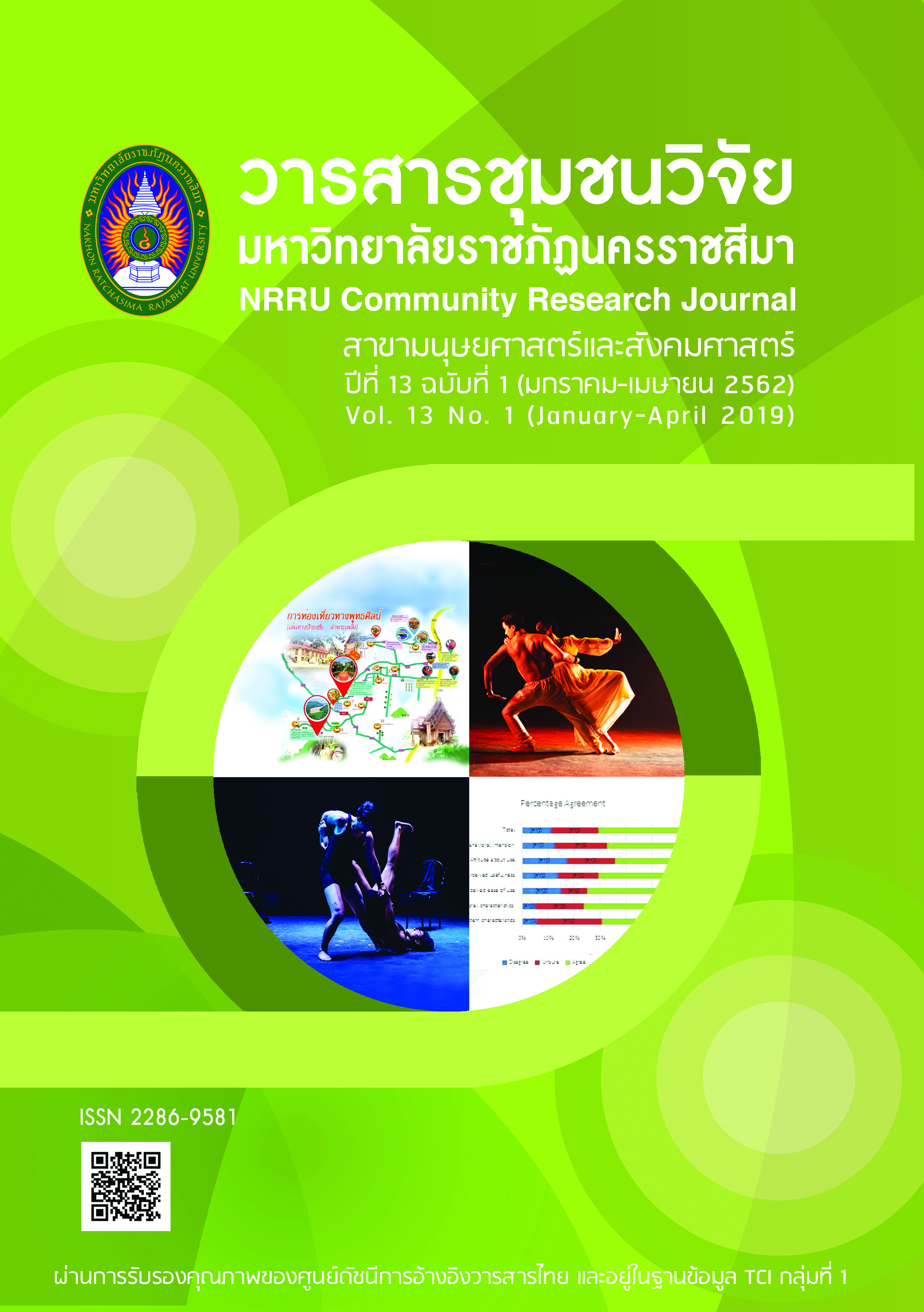IMPLEMENTING FLIPPED COOPERATIVE CLASSROOM LEARNING IN A READING COMPREHENSION COURSE
DOI:
https://doi.org/10.14456/10.14456/nrru-rdi.2019.9Keywords:
Reading comprehension course, Flipped classroom, Cooperative learning, Model implementationAbstract
The objective of this study was to implement and find guidelines for improving a Flipped Cooperative Classroom model in a reading comprehension course. The Flipped Cooperative Classroom model was developed in response to solving problems of low reading comprehension of university students as the results of their lack of reading strategies and low reading motivation. This model was adapted from pre-existing available models to suit the instructional goal. Major features which made the Flipped Cooperative Classroom model differ from other previous ones were the use of cooperative learning and the online learning management system. The model was implemented with a class of 32 English major students at Nakhon Ratchasima Rajabhat University. The implementation results were assessed by means of students’ pre- and post-test scores and students’ responses to learning experience questionnaires. The questionnaire contained a total of 36 items with the overall content validity of 0.76. Statistics used for data analysis included t-test, frequency, percentage, and mean. Open-ended responses were analyzed using content-analysis method. The results showed that the developed Flipped Cooperative Classroom model was rated at ‘Suitable’ level, and the students had positive opinions about learning with the Flipped Cooperative Classroom model, although pre-test and post-test scores were not significantly different. The study results suggested some modifications needed with some parts of the Flipped Cooperative Classroom model for better effectiveness.
References
Bishop, J. L., & Verleger, M. A. (2013). The flipped classroom: a survey of the research. In ASEE National Conference Proceedings, GA : Atlanta.
Boonyapakob, K., Vivekmetakorn, C. K., & Jitpranee, J. (2012). Teachers’ Instructional Practices in Large EFL Classes in a Thai University Context. SALT.
Chomchaiya, C. & Dunworth, K. (2008). Identification of Learning Barriers Affecting English Reading Comprehension Instruction, as Perceived by ESL Undergraduates in Thailand. Edith Cowan University. EDU-COM International Conference, 96-104.
Chomchaiya, C. (2014). An investigation into the development of English language reading comprehension among Thai undergraduate students using an online blended learning approach. Degree of Doctor of Philosophy, Curtin University, Singapore .
Enfield, J. (2013). Looking at the Impact of the Flipped Classroom Model of Instruction on Undergraduate Multimedia Students at CSUN. TechTrends TECHTRENDS TECH TRENDS, 57(6), 14-27. doi: 10.1007/s1152801306981
Erbil, D. G., & Kocabas, A. (2016, September). The Flipped Classroom Based On Cooperative Learning Method in Elementary Schools: Possibilities and A Model Proposal. Intercultural Education at the Crossroads Conferenve in which organized between the dates of 5-9 September 2016. Budapest, Hungary.
Gulbinskienė, D., Masoodi, M., & Šliogerienė, J. (2017). Moodle as Virtual Learning Environment in Developing Language Skills, Fostering Metacognitive Awareness and Promoting Learner Autonomy. Pedagogika, 127(3), 176-185.
Hayikaleng, N., Nair, S. M., & Krishnasamy, H. N. (2016). Thai students’ L2 reading comprehension level for lower order thinking skills and higher order thinking skills questions. Journal of Applied Linguistics and Language Research, 3(5), 83-91.
Huang, Y. N., & Hong, Z. R. (2016). The effects of a flipped English classroom intervention on students’ information and communication technology and English reading comprehension. Educational Technology Research and Development, 64(2), 175-193.
Jacob, E., Rottenberg, L., Patrick, S., & Wheeler, E. (1996). Cooperative learning: Context and opportunities for academic English. TESOL Quarterly, 30, 253-280.
Jing, M. (2016). The application of Moodle-based platform in college English learning. Sino-US English Teaching, 13(5), 332-337.
Karimi, M., & Hamzavi, R. (2017). The Effect of Flipped Model of Instruction on EFL Learners’ Reading Comprehension: Learners’ Attitudes in Focus. Advances in Language and Literary Studies, 8(1), 95-103.
Kasemsap, B., & Lee, H. Y. (2015). The Reading Matrix. An International Online Journal, 15(2), 101-117.
Kim, M. K., Kim, S. M., Khera, O., & Getman, J. (2014). The experience of three flipped classrooms in an urban university: An exploration of design principles. The Internet and Higher Education, 22, 37-50. doi: 10.1016/j.iheduc.2014.04.003
Lee, J., Lim, C., & Kim, H. (2017). Development of an instructional design model for flipped learning in higher education. Educational Technology Research & Development, 65(2), 427-453. doi:10. 1007/s11423-016-9502-1.
Lehr, F. & Osborne, J. (2006). Focus on comprehension. Pacific Regional Educational Laboratory. Retrived March 20, 2012, from http://textproject.org/ assets/library/resources/Lehr-Osborn-Hiebert-2005-A-Focus-on-Comprehension-booklet.pdf
Liu, C. & Liu, Z. (2016). A Creative Design and Implementation of Student-led Flipped Classroom Model in English Learning. Theory and Practice in Language Studies, 6(10), 2036-2043.
Puangmaliwan, P. (2005). Enhancing reading comprehension, vocabulary recognition and attitude towards extensive reading: A case study of the first-year English majors in the academic year 2004 at Nakhon Ratchasima Rajabhat University. Degree of Master Arts in English Language Studies, Suranaree University of Technology, Nakhon Ratchasima.
Sawangsamutchai, Y., & Rattanavich, S. (2016). A Comparison of Seventh Grade Thai Students’ Reading Comprehension and Motivation to Read English through Applied Instruction Based on the Genre-Based Approach and the Teacher’s Manual. Retrived March 1, 2016, from http://dx. doi.org/10.5539/elt.v9n4p54 doi: 10.5539/elt.v9n4p54.
Sharan, S. (1994). Cooperative learning and the teacher. In S. Sharan (Ed.).,The handbook of cooperative learning methods (pp. 336-348). Westport, CT : Praeger Publisher.
Siriphanich, P., & Laohawiriyanon, C. (2010). Using mind-mapping technique to improve reading comprehension ability of Thai EFL University Students. International Conference on Humanities and Social Sciences, 2(1), 1-13.
Stahl, R. J. (1995). Cooperative learning: A language arts context and an overview. In R. J. Stahl. (Ed.), Cooperative learning in language arts (pp. 1-16). Menlo Park, CA : Addison-Wesley.
Strauss, M. J. (2008). Reading habits and attitudes of Thai L2 students (MA Thesis). Retrieved August 25, 2009, from https://www.academia.edu/people/search?utf8=%E2%9C%93&q=READING+ HABITS+AND+ATTITUDES+OF+THAI+L2+STUDENTS
Tamrackitkun, K. (2010). Extensive Reading: An Empirical Study of Its Effects on EFL Thai Students’ Reading Comprehension, Reading Fluency and Attitudes. Degree of Doctor of Philosophy University of Salford, Salford, UK.
Todd, R. W. (2012). The effects of class size on English learning at a Thai university. International Association of Research in Foreign Language Education and Applied Linguistics ELT Research Journal, 1(1), 80-88.
Uraiman, Y. (2011). Developing secondary school students’ reading ability and motivation using an extensive reading program. Master of Arts Degree in English, Srinakharinwirot University, Nakhon Pathom.





